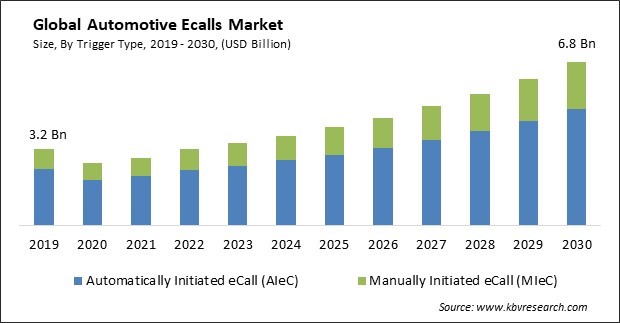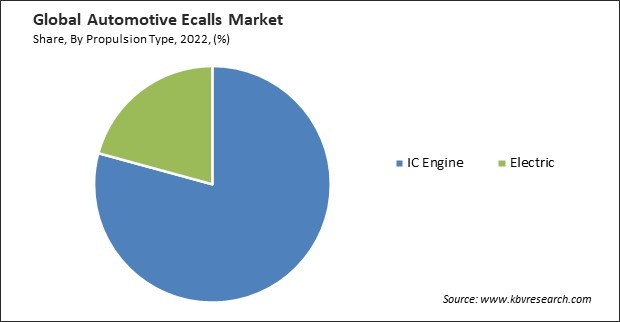The Global Automotive Ecalls Market size is expected to reach $6.8 billion by 2030, rising at a market growth of 10.3% CAGR during the forecast period.
The World Health Organization states that roughly 1.3 million individuals die annually in road traffic accidents. 93% of global road fatalities occur in low- and middle-income countries, even though these nations possess approximately 60% of the world's vehicles. MIeC serves as a crucial safety net, allowing drivers or passengers to swiftly summon help when faced with a critical situation. Consequently, the Manually Initiated eCall (MieC) segment would generate approximately 1/5thshare of the market by 2030. By offering this manual initiation option, automotive eCall systems provide an extra layer of security, ensuring rapid response from emergency services. This enables quicker dispatch of medical assistance to the scene, reducing the time injured individuals have to wait for medical care. This is particularly important in severe accidents where rapid medical intervention can substantially affect outcomes. Some of the factors affecting the market are the development of next-generation telematics, stringent government regulations regarding safety, and compatibility with existing infrastructure for ecall systems.

The development of next-generation telematics protocols is a substantial factor contributing to the growth of the market. Telematics protocols enable communication between vehicles and external systems, including eCall systems. Next-generation telematics protocols, such as 5G and advanced versions of 4G LTE, offer significantly faster data transmission speeds and lower latency. This enables eCall systems to transmit a wider range of data quickly and reliably. These protocols enable faster, more reliable, and data-rich communication between vehicles and emergency services, ultimately enhancing road safety and the effectiveness of eCall responses. As a result, they play a crucial role in supporting the growth and adoption of eCall technology in the automotive industry and, thus, propel the growth of the market. Moreover, Governments worldwide have recognized the potential of eCall technology to enhance road safety and emergency response, leading to the implementation of regulations that mandate the inclusion of eCall systems in new vehicles. These regulations align with broader goals of improving road safety and emergency response, and they drive the adoption of eCall technology by automakers and consumers, ultimately propelling market growth.
However, the compatibility of automotive eCall systems with existing infrastructure can present challenges for the market. These challenges arise from ensuring that eCall systems can connect with and transmit data to emergency services and other infrastructure elements. Different regions and nations have varying levels of technological infrastructure for emergency response and communication. ECall systems must be compatible with various infrastructure configurations, from advanced urban centers to rural areas with limited resources. Some regions may have legacy emergency response systems that rely on older technologies and protocols. Thus, the complexity of automotive ecalls will decline the expansion of the market growth.
On the basis of trigger type, the market is bifurcated into automatically initiated eCall (AIeC) and manually initiated eCall (MieC). The automatically initiated eCall (AIeC) segment garnered the highest revenue share in the market in 2022. One of the primary benefits of AIeC is its ability to initiate an emergency call immediately after a severe accident, without the need for driver intervention. This rapid response can be crucial in situations where every second counts, potentially saving lives. AIeC systems provide accurate and detailed information about the accident's location, severity, and the number of occupants in the vehicle. This information helps emergency services respond more effectively and dispatch appropriate resources.
Based on propulsion type, the market is divided into IC engine and electric. The electric segment recorded a considerable growth rate in the market in 2022. Growing concerns about air pollution and climate change have led consumers to seek cleaner and more sustainable transportation options. EVs produce zero tailpipe emissions, making them an attractive choice for environmentally conscious buyers. Automakers are offering an increasing variety of EV models, including sedans, SUVs, and even trucks. This diversity allows consumers to find an EV that suits their preferences and needs. eCall systems in Evs prioritize user privacy and data protection.

By vehicle type, the market is segmented into passenger cars and commercial vehicles. The passenger cars segment witnessed the maximum revenue share in the market in 2022. eCall systems in passenger cars are instrumental in improving road safety, reducing response times in emergencies, and ensuring that help is promptly dispatched when needed. They offer a level of safety and security that is increasingly important in modern vehicles, contributing to overall traffic safety and the well-being of vehicle occupants.
| Report Attribute | Details |
|---|---|
| Market size value in 2022 | USD 3.2 Billion |
| Market size forecast in 2030 | USD 6.8 Billion |
| Base Year | 2022 |
| Historical Period | 2019 to 2021 |
| Forecast Period | 2023 to 2030 |
| Revenue Growth Rate | CAGR of 10.3% from 2023 to 2030 |
| Number of Pages | 216 |
| Number of Table | 320 |
| Report coverage | Market Trends, Revenue Estimation and Forecast, Segmentation Analysis, Regional and Country Breakdown, Companies Strategic Developments, Company Profiling |
| Segments covered | Trigger Type, Propulsion Type, Vehicle Type, Region |
| Country scope | US, Canada, Mexico, Germany, UK, France, Russia, Norway, Netherlands, China, Japan, India, South Korea, Singapore, Malaysia, Brazil, Argentina, UAE, Saudi Arabia, South Africa, Nigeria |
| Growth Drivers |
|
| Restraints |
|
Region-wise, the market is analyzed across North America, Europe, Asia Pacific, and LAMEA. The Asia Pacific region covered a considerable revenue share in the market in 2022. Developing countries, specifically in Asia, such as South Korea, India, Japan, and others, have demonstrated a growing commitment to enhancing automotive safety through the extensive adoption of eCall systems in vehicles. These nations recognize the potential of such technology to address their unique road safety challenges and mitigate the devastating impact of road accidents. These devices facilitate immediate assistance in emergencies and aid in tracking vehicle movements, driver behavior monitoring, and overall fleet management, further boosting the market growth.
Free Valuable Insights: Global Automotive Ecalls Market size to reach USD 6.8 Billion by 2030
The market research report covers the analysis of key stakeholders of the market. Key companies profiled in the report include Aptiv PLC, Telit corporate group (DBAY Advisors Limited), LG Electronics, Inc. (LG Corporation), Valeo SA, Samsung Electronics Co., Ltd. (Samsung Group), U-blox Holding AG, Thales Group S.A., Denso Corporation, Continental AG, Panasonic Holdings Corporation.
By Trigger Type
By Propulsion Type
By Vehicle Type
By Geography
This Market size is expected to reach $6.8 billion by 2030.
Development of next generation telematics are driving the Market in coming years, Compatibility with existing infrastructure for ecall systems restraints the growth of the Market.
Aptiv PLC, Telit corporate group (DBAY Advisors Limited), LG Electronics, Inc. (LG Corporation), Valeo SA, Samsung Electronics Co., Ltd. (Samsung Group), U-blox Holding AG, Thales Group S.A., Denso Corporation, Continental AG, Panasonic Holdings Corporation.
The expected CAGR of this Market is 10.3% from 2023 to 2030.
The IC Engine segment is leading the Market by Propulsion Type in 2022; thereby, achieving a market value of $5.2 billion by 2030.
The Europe region dominated the Market by Region in 2022 and would continue to be a dominant market till 2030; thereby, achieving a market value of $2.3 billion by 2030.
Our team of dedicated experts can provide you with attractive expansion opportunities for your business.

